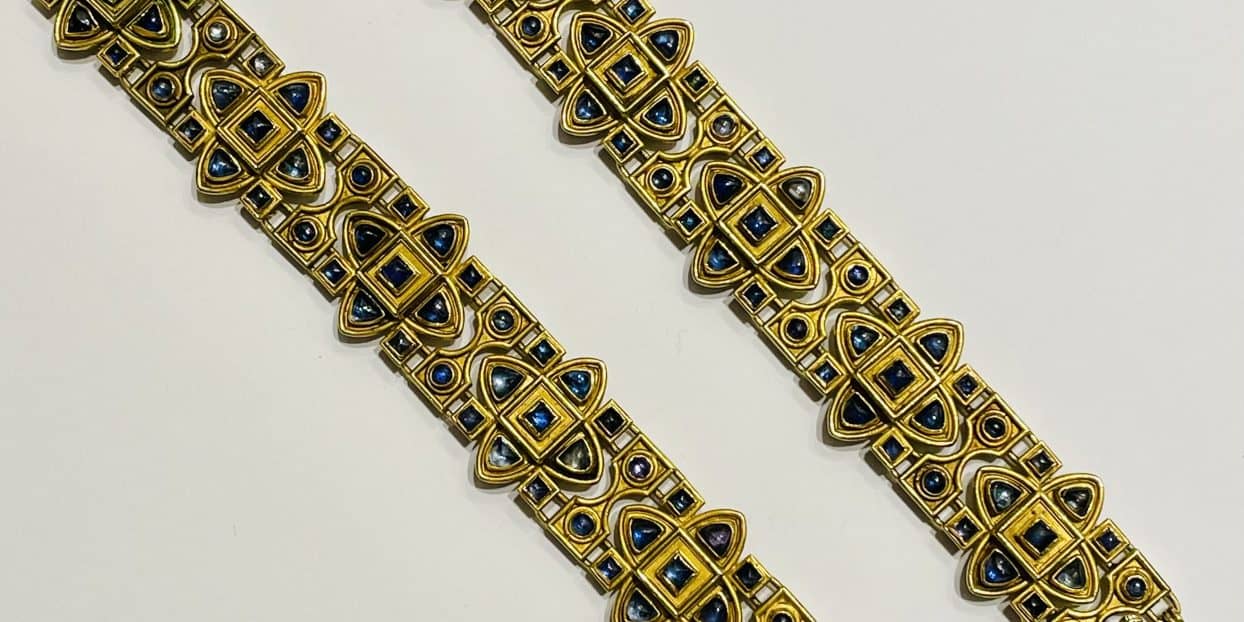Posted: 29 May 2024
Category: Company News
Castellani jewellery

I discovered this pair of magnificent gothic revival gold bracelets set with sugar loaf and cabochon sapphires on a standard probate valuation in Hove.
I was informed by the family that there was only a collection of costume jewellery, so imagine my surprise and sheer delight when I spied these amongst the items present. I knew immediately what they were and who they were by, which was confirmed by the interlocking CC mark on the reverse of each bracelet. The family had no idea where they had come from and were staggered when I told them they were worth a five figure sum.
They were recently offered in an international jewellery auction with a guide price of £25,000 – £30,000 and sold at the top end for £30,000.
The 19th century witnessed a revival of various artistic and architectural styles, reflecting a nostalgic yearning for the grandeur of past eras. Among these, the Gothic Revival stood out, characterized by a resurgence of medieval motifs and craftsmanship. One of the most illustrious contributors to this movement in the realm of jewellery was the Castellani family. Their work, renowned for its meticulous craftsmanship and historical authenticity, continues to captivate connoisseurs and collectors alike.
Origins and Inspiration
The Gothic Revival movement emerged in the early 19th century as a counterpoint to the neoclassical aesthetic that had dominated European art and design. Rooted in the romanticization of the medieval period, the Gothic Revival celebrated the intricate designs, pointed arches, and religious symbolism characteristic of Gothic architecture. This stylistic resurgence extended beyond buildings, influencing furniture, decorative arts, and jewellery.
The Castellani family, particularly Fortunato Pio Castellani and his sons, Alessandro and Augusto, played a pivotal role in this revival. Based in Rome, the Castellani family was deeply invested in the preservation and revival of ancient jewellery-making techniques. They drew inspiration from the rich history of Italian craftsmanship, ranging from Etruscan and Roman designs to medieval Gothic styles.
Craftsmanship and Design
Castellani jewellery is distinguished by its exceptional quality and attention to detail. The family employed ancient techniques such as granulation and filigree, which they meticulously studied and revived. Granulation involves creating patterns with tiny gold spheres, while filigree uses fine gold wires to create delicate, lace-like designs. These techniques allowed the Castellani artisans to create pieces that were both intricate and durable, capturing the essence of medieval artistry.
The Gothic Revival pieces crafted by Castellani often featured motifs such as quatrefoils, trefoils, and pointed arches, all emblematic of Gothic architecture. Religious symbols, including crosses and sacred hearts, were also prevalent, reflecting the spiritual fervor of the medieval period. Gemstones such as garnets, sapphires, and emeralds were commonly used, set in elaborate gold settings that highlighted their vibrant colors.
Legacy and Influence
The Castellani family’s dedication to authenticity and historical accuracy earned them a prestigious reputation. Their jewellery was highly sought after by European aristocracy and collectors, and they were instrumental in the broader Gothic Revival movement in decorative arts. The Castellani atelier became a hub for scholars and artisans interested in historical jewellery, fostering a renewed appreciation for ancient techniques.
In addition to their artistic contributions, the Castellani family was involved in the burgeoning field of archaeology. Alessandro Castellani, in particular, was an avid collector of antiquities and played a significant role in the establishment of several museum collections. The family’s work not only adorned the elite but also contributed to the academic study and preservation of historical artefacts.
Modern Appreciation
Today, Castellani Gothic Revival jewellery remains highly prized among collectors and historians. Museums around the world, including the British Museum and the Victoria and Albert Museum, house collections of Castellani pieces, showcasing their intricate beauty and historical significance. Auctions featuring Castellani jewellery attract significant interest, with pieces often fetching high prices due to their rarity and craftsmanship.
The enduring appeal of Castellani Gothic Revival jewellery lies in its combination of historical reverence and artistic innovation. Each piece serves as a testament to the family’s dedication to preserving ancient techniques and their ability to adapt these methods to contemporary tastes. The jewellery not only evokes the splendor of the medieval past but also reflects the 19th-century fascination with history and craftsmanship.
Conclusion
Castellani Gothic Revival jewellery stands as a luminous chapter in the history of decorative arts. The family’s commitment to reviving ancient techniques and their passion for historical accuracy resulted in creations that are as much works of art as they are pieces of jewellery. Today, the legacy of the Castellani family continues to inspire and captivate, a testament to the enduring allure of the Gothic Revival and the timeless beauty of masterful craftsmanship.
CALL 01273 838348 TO SPEAK TO AN ADVISOR OR MAKE AN ONLINE ENQUIRY




